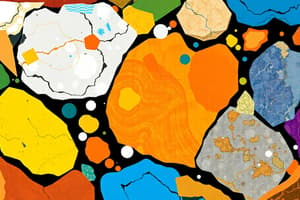Podcast
Questions and Answers
Which mineral classification group is characterized primarily by the presence of silicon and oxygen?
Which mineral classification group is characterized primarily by the presence of silicon and oxygen?
- Non-silicates
- Carbonates
- Sulfides
- Silicates (correct)
What mineral test involves scratching a mineral on a porcelain plate to observe the color of its powder?
What mineral test involves scratching a mineral on a porcelain plate to observe the color of its powder?
- Luster test
- Cleavage test
- Hardness test
- Streak test (correct)
Which of the following is a characteristic of a mineral that has a metallic luster?
Which of the following is a characteristic of a mineral that has a metallic luster?
- It transmits light.
- It appears dull.
- It is always opaque.
- It is shiny and reflective. (correct)
Which of the following mineral categories includes halite and fluorite?
Which of the following mineral categories includes halite and fluorite?
What distinguishes ore minerals from industrial minerals?
What distinguishes ore minerals from industrial minerals?
Flashcards are hidden until you start studying
Study Notes
Mineral Identification
- Visual Inspection: Color, luster, and transparency.
- Hardness: Measured using Mohs scale (1-10).
- Streak: Color of the mineral’s powder when scratched on a porcelain plate.
- Cleavage and Fracture:
- Cleavage: Tendency to break along flat surfaces.
- Fracture: Irregular breakage.
- Specific Gravity: Density comparison to water.
- Acid Test: Reaction with hydrochloric acid indicating carbonate minerals.
Rock-forming Minerals
- Silicates: Made up of silicon and oxygen; dominant group.
- Examples: Quartz, feldspar, mica.
- Non-silicates: Include several subgroups.
- Carbonates (e.g., calcite)
- Oxides (e.g., hematite)
- Sulfates (e.g., gypsum)
Mineral Properties
- Color: Often variable; not a reliable identification method.
- Luster:
- Metallic: Shiny, reflective.
- Non-metallic: Dull, glassy, or pearly.
- Transparency: Clear, translucent, or opaque.
- Texture: Crystal size, shape, and arrangement.
- Other Tests:
- Magnetism
- Taste (e.g., halite is salty)
- Luminescence
Mineral Classification
- Silicate Minerals:
- Framework (e.g., quartz)
- Sheet (e.g., mica)
- Chain (e.g., pyroxene)
- Non-Silicate Minerals:
- Native elements (e.g., gold)
- Carbonates (e.g., calcite)
- Halides (e.g., fluorite)
- Oxides (e.g., magnetite)
- Sulfides (e.g., pyrite)
Economic Minerals
- Ore Minerals: Contain valuable metals.
- Examples: Bauxite (aluminum), galena (lead).
- Industrial Minerals: Used in manufacturing and construction.
- Examples: Talc (paint), gypsum (drywall).
- Gemstones: Valued for beauty and rarity.
- Examples: Diamond, ruby, sapphire.
- Energy Minerals: Fossil fuels and nuclear resources.
- Examples: Coal, uranium.
Mineral Identification
- Visual inspection evaluates color, luster, and transparency to distinguish minerals.
- Hardness is assessed using the Mohs scale, ranging from 1 (talc) to 10 (diamond).
- Streak refers to the color of a mineral's powder obtained by scraping it on a porcelain plate.
- Cleavage represents a mineral's ability to break along flat surfaces; fracture indicates irregular breakage patterns.
- Specific gravity measures a mineral's density in relation to water.
- The acid test determines the presence of carbonate minerals through a reaction with hydrochloric acid.
Rock-forming Minerals
- Silicates account for the majority of Earth's crust and consist of silicon and oxygen; common examples include quartz, feldspar, and mica.
- Non-silicates encompass various subgroups, including:
- Carbonates (calcite)
- Oxides (hematite)
- Sulfates (gypsum)
Mineral Properties
- Color can vary significantly among minerals, making it unreliable for identification.
- Luster can be categorized as:
- Metallic, which appears shiny and reflective
- Non-metallic, which may be dull, glassy, or pearly in appearance
- Transparency classifies minerals as clear, translucent, or opaque.
- Texture encompasses crystal size, shape, and overall arrangement.
- Additional tests for identification may include:
- Magnetism (magnetic response)
- Taste (e.g., halite has a salty flavor)
- Luminescence (ability to emit light)
Mineral Classification
- Silicate minerals are further divided into structural types:
- Framework (e.g., quartz)
- Sheet (e.g., mica)
- Chain (e.g., pyroxene)
- Non-silicate minerals categories include:
- Native elements (e.g., gold)
- Carbonates (e.g., calcite)
- Halides (e.g., fluorite)
- Oxides (e.g., magnetite)
- Sulfides (e.g., pyrite)
Economic Minerals
- Ore minerals are those that contain valuable metals, such as bauxite (for aluminum) and galena (for lead).
- Industrial minerals are essential for manufacturing and construction, with examples including talc (used in paint) and gypsum (used in drywall).
- Gemstones are prized for their aesthetics and rarity, including diamonds, rubies, and sapphires.
- Energy minerals encompass resources used for energy production, including fossil fuels (e.g., coal) and nuclear materials (e.g., uranium).
Studying That Suits You
Use AI to generate personalized quizzes and flashcards to suit your learning preferences.




